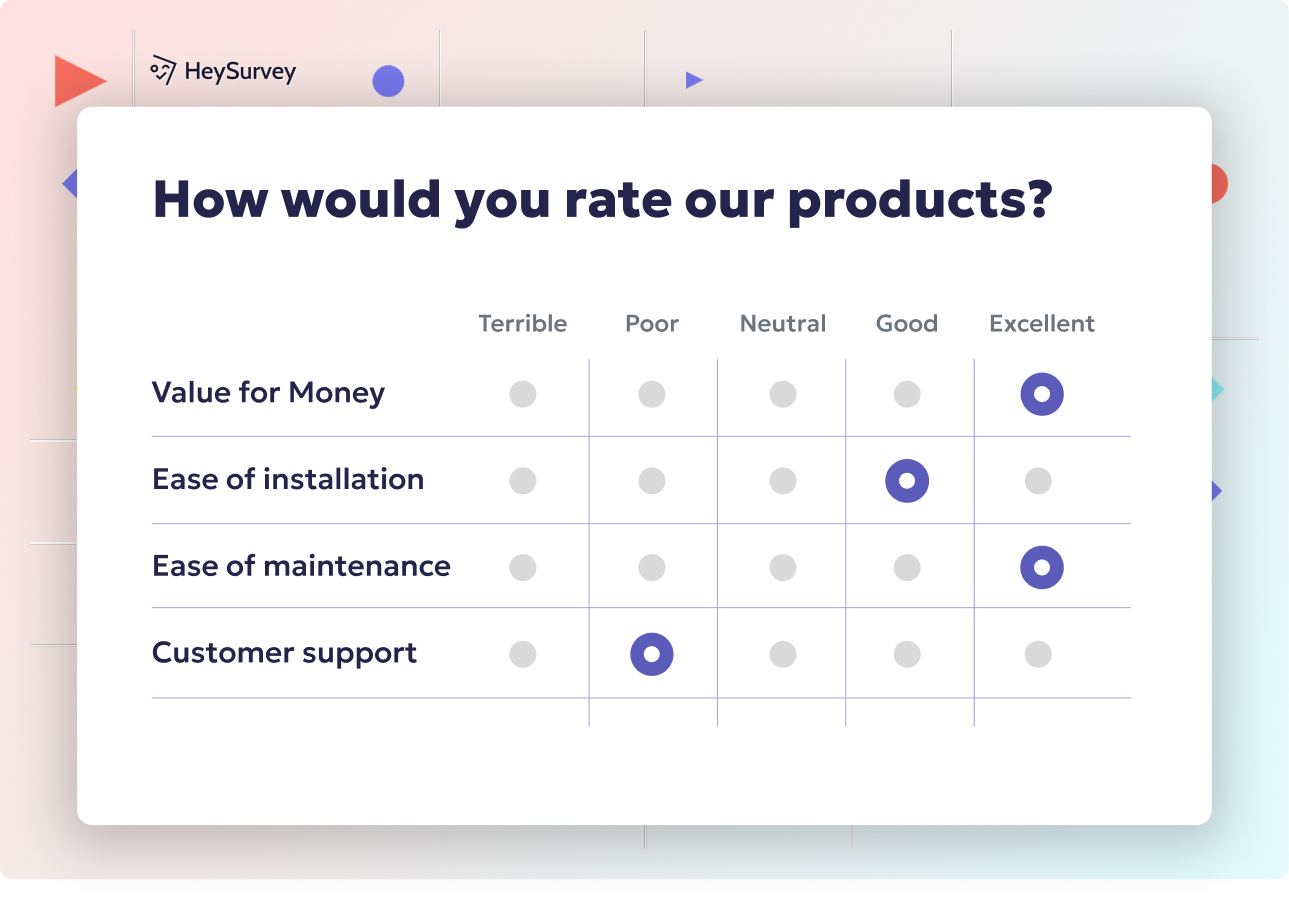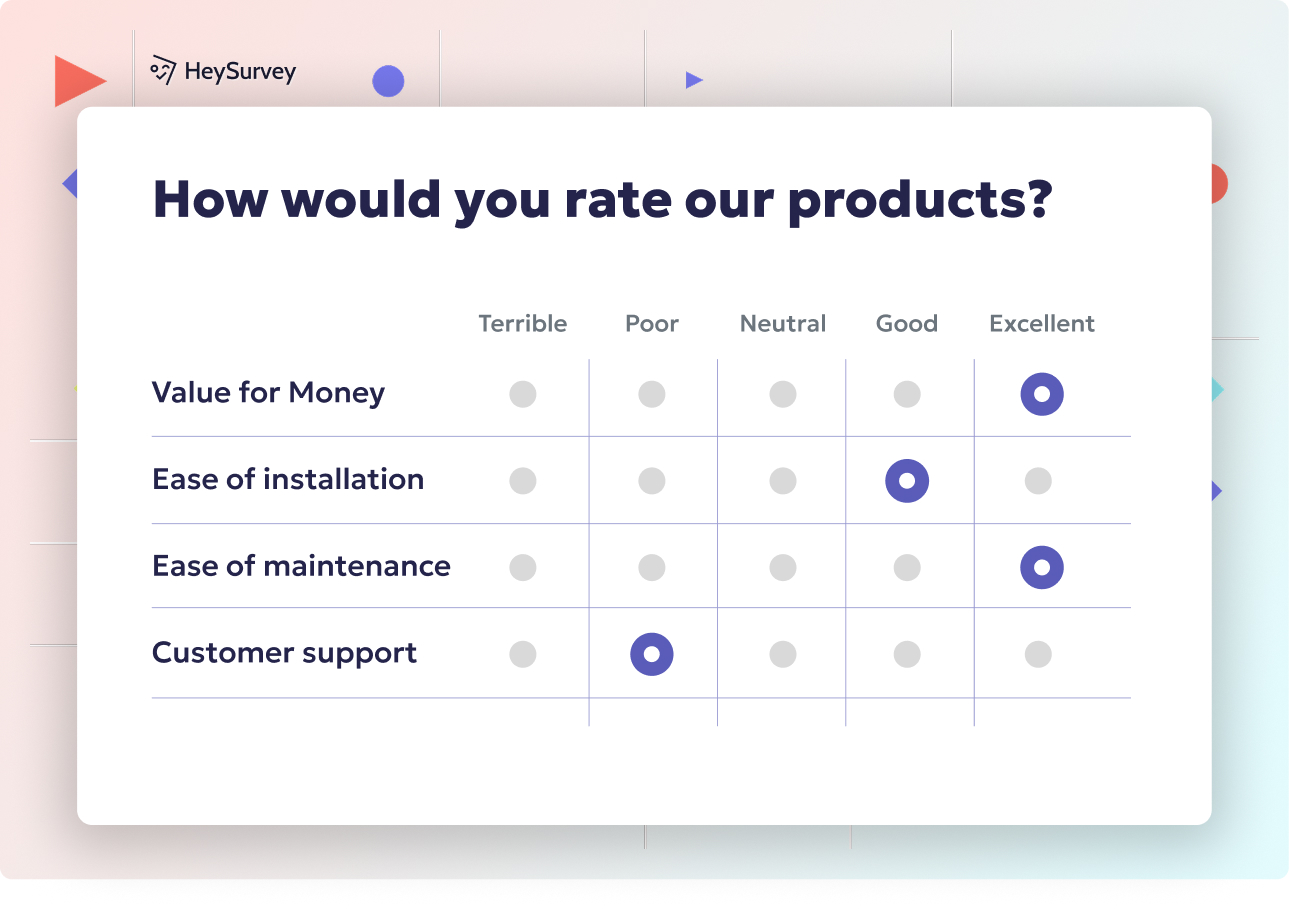30 Employee Performance Survey Questions for Better Reviews
Discover 30+ employee performance survey questions with sample queries covering self-assessment, 360-feedback, peer reviews, and more for better evaluations.
In today’s fast-moving workplaces, employee performance survey questions are like rocket fuel for company growth. When teams deploy the right performance evaluation questionnaires at just the right moment, they unlock a wave of actionable data, deeper engagement, and laser-sharp alignment between daily work and big-picture company goals. Want to know when these staff appraisal surveys create the most magic? It’s during quarterly check-ins, post-project wrap-ups, or even right after the probation period. Here’s your ultimate guide to employee performance survey questions with big impact.
Self-Assessment Surveys
Why & When Self-Assessment Matters
Self-assessment surveys serve as a mirror for employees, empowering them to reflect on accomplishments and setbacks. They are most effective when distributed before formal performance reviews, giving staffers a chance to own their achievements and identify growth areas before any feedback comes their way.
These performance evaluation questionnaires encourage a culture of ownership and self-awareness. Team members regularly reminded to check their own progress tend to feel more engaged and invested in their growth. When survey responses are compared with manager feedback, rich conversations emerge, often leading to fresh insights and renewed motivation.
In an environment where self-reflection is championed, everybody wins—employees, managers, and, most importantly, your organization’s bottom line. The best time to deploy these staff appraisal surveys?
- Before scheduled review cycles
- As part of personal development plans
- Anytime employees set new quarterly or project goals
5 Essential Self-Assessment Survey Questions
Which recent accomplishment are you most proud of and why?
On a 1–10 scale, how effectively do you prioritize tasks?
What skill would you most like to develop in the next quarter?
Describe a challenge you faced recently and how you resolved it.
How do your daily activities align with our company’s core values?
When employees answer with candor, self-assessment surveys become a launchpad for coaching conversations that go far beyond tick-the-box reviews. The insight harvested from these surveys can transform performance management into a dynamic, two-way street.
Incorporating self-assessments into performance reviews can increase employee engagement by 25% and boost productivity by 15%. (psicosmart.net)
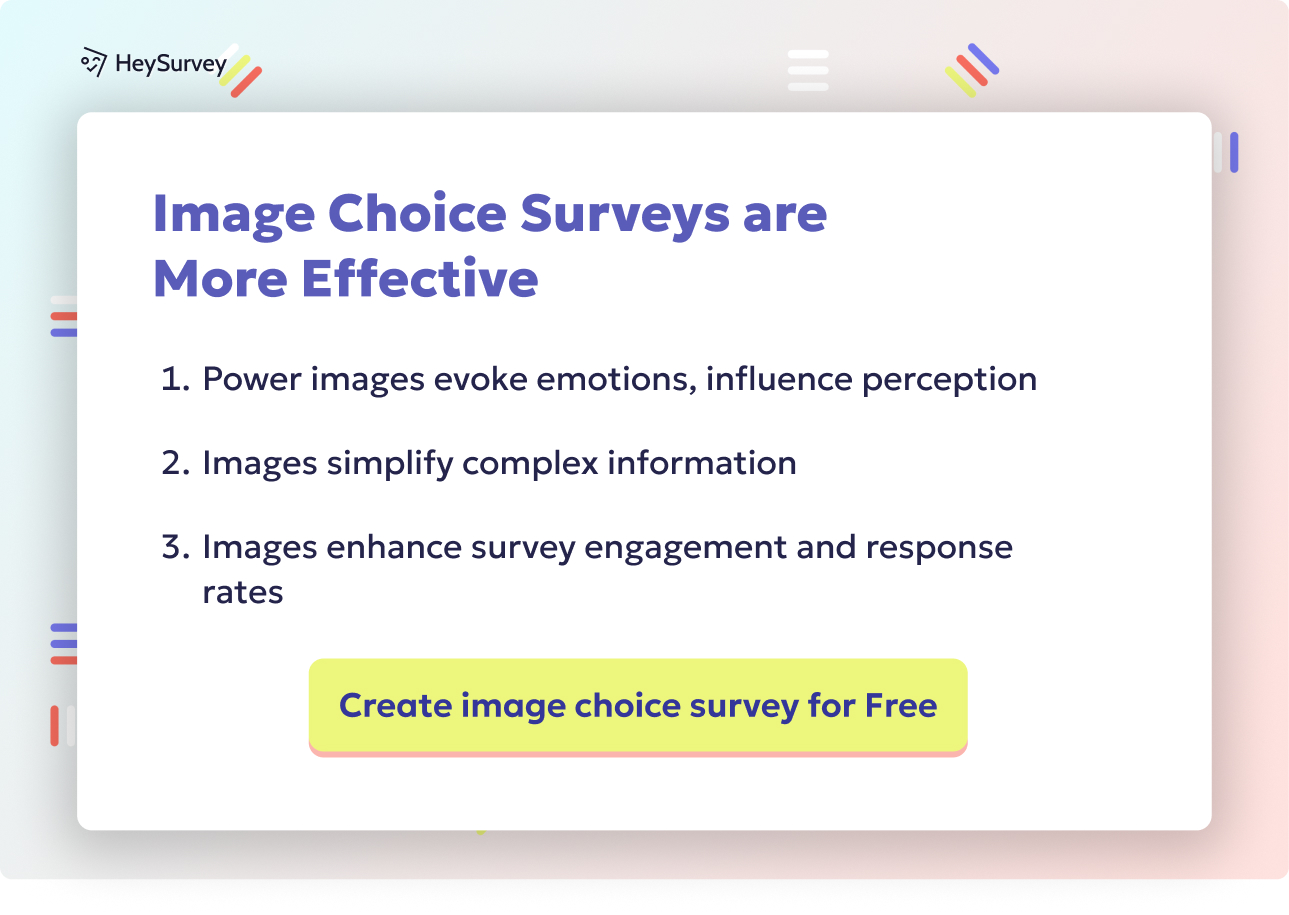
Creating a survey with HeySurvey is super simple—perfect for beginners keen on launching their own employee performance survey questions without pulling out their hair. Just follow these 3 easy steps to get started, plus a couple of bonus tips to make your survey shine!
Step 1: Create a New Survey
- Head to the HeySurvey dashboard and click “Create New Survey.”
- You can start with a blank slate or pick one of the handy pre-built templates designed for employee performance surveys.
- Give your survey a clear, internal name so you’ll find it easily later.
Step 2: Add Your Questions
- Click “Add Question” at the top or between existing questions.
- Choose question types that fit your needs: multiple choice, text boxes, rating scales, and more.
- Paste or type in your carefully crafted performance questions—like self-assessment or peer review queries.
- Mark questions as required if you want to make sure respondents don’t skip them.
Step 3: Publish Your Survey
- When your questions look good, click “Preview” to see exactly what participants will experience.
- If you want to tweak colors or fonts, jump into the Designer Sidebar before publishing.
- Finally, hit “Publish” to get a shareable link or embed code. (Heads up: Publishing requires a free account.)
Bonus Step: Apply Branding
Make your survey unmistakably yours by uploading your company logo and customizing colors in the Designer Sidebar.
Bonus Step: Define Settings or Add Branching
- Set start/end dates to control when your survey’s live.
- Limit the number of responses if you have a quota.
- Use branching logic to send respondents down different paths based on their answers—perfect for tailoring performance reviews.
Ready to skip the setup hassle? Just click the button below to open a ready-made employee performance survey template and start customizing in seconds!
360-Degree Feedback Surveys
Why & When to Use 360-Degree Feedback
To get the fullest picture of an employee’s performance, 360-degree feedback is king. These performance evaluation questionnaires funnel insights from not just managers, but also peers and direct reports—to weave a feedback tapestry as multi-layered as your people.
The true magic of these staff appraisal surveys shines in
- Leadership development initiatives
- Succession planning exercises
- Annual or biannual reviews for critical roles
Involving diverse voices ensures nobody flies under the radar. Team members see firsthand how their actions ripple outward, reinforcing behaviors that lift the whole group. Leaders get an unvarnished snapshot of where they truly stand, not just how they hope to be seen.
360-degree feedback works best when administered at regular intervals or after major team milestones. It’s an open invitation for holistic growth, fuelled by actionable, well-rounded input. Use these staff appraisal surveys to highlight hidden strengths, address developmental blind spots, and spark meaningful dialogue.
5 Sample 360-Degree Feedback Questions
How well does this employee communicate expectations across teams?
Rate their openness to constructive criticism (1–5).
Provide an example of when this employee demonstrated strong collaboration.
How effectively does this employee mentor or coach others?
What one behavior should they continue, start, or stop?
Answers to these employee performance survey questions can directly shape development plans and succession roadmaps—offering clarity that’s hard to achieve with manager-only reviews.
A 2025 survey revealed that 79% of employees would opt out of 360-degree feedback, citing concerns over bias and unfairness. (shrm.org)
Manager-to-Employee Performance Surveys
Why & When to Use Manager Assessments
Manager-to-employee performance surveys are the backbone of every performance management system. These direct assessments allow leaders to measure progress against tangible goals, ensuring KPIs aren’t left up in the air.
Deploy these surveys
- During annual, semi-annual, or quarterly appraisal cycles
- When rolling out SMART goal frameworks
- For tracking ongoing professional development or remedial plans
Because these surveys come from managers—the people most closely observing employees day-to-day—the feedback is focused, relevant, and directly tied to business outcomes. Done right, these staff appraisal surveys encourage robust one-on-one conversations, with clear action steps and accountability for all.
These manager-driven questionnaires aren’t just about grading; they’re a performance calibration tool—aligning team output with organizational strategy and culture, while supporting continuous improvement.
5 Key Manager-to-Employee Survey Questions
Which key metrics has the employee met, exceeded, or missed?
How consistently does the employee meet project deadlines?
Describe the quality of the employee’s problem-solving approach.
What development opportunities should be prioritized next period?
How effectively does the employee embody our organizational culture?
When these performance evaluation questionnaires are delivered with transparency and empathy, they turn annual reviews from dreaded rituals into authentic, growth-centered exchanges.
Peer Review Surveys
Why & When Peer Reviews Are Game-Changers
Sometimes, the people who know your workplace heroes best are their teammates. Peer review surveys capture real-time, ground-level perspectives that even the keenest manager might overlook.
These surveys excel in
- Agile workplaces with rotating teams
- Cross-functional project environments
- Collaborative departments where teamwork drives results
By giving coworkers a stake in each other’s development, peer reviews strengthen team dynamics—not with generic praise, but with meaningful examples of trust, reliability, and creative problem-solving. Peer-based staff appraisal surveys promote candid conversation, elevating team performance by calling out everyday wins and surfacing opportunities for improvement.
To keep feedback useful and (mostly) friendly, roll out these employee performance survey questions at regular intervals, or as part of retrospectives after big milestones.
5 Essential Peer Review Survey Questions
How reliable is this colleague when sharing responsibilities?
Rate their ability to listen and incorporate peer feedback (1–5).
Give an example of the employee supporting team success.
How well does this person resolve interpersonal conflict?
What improvement would enhance team synergy?
Peer review results often spotlight the glue that holds teams together. By surfacing this insight, performance evaluation questionnaires make it easier to replicate positive behaviors—while giving everyone a voice in their workplace culture.
Implementing peer feedback systems can boost employee performance by up to 14%. (gartner.com)
Project-Based Performance Surveys
Why & When to Use Project-Based Surveys
Every project is a story in itself—a whirlwind of tight deadlines, shifting targets, and teamwork under pressure. Project-based performance surveys capture fresh, context-rich feedback at the perfect moment.
Deploy these questionnaires
- Immediately after project closeout meetings
- For post-mortems of major deliverables
- To gather client or stakeholder input on team effectiveness
These performance evaluation questionnaires give employees a chance to reflect on their real-time achievements and lessons learned. They’re especially useful for identifying skills and behaviors that help—or hinder—project success, making each new engagement smoother and more effective.
By asking timely, specific questions, companies turn project wrap-ups into powerful learning opportunities—cutting out hindsight bias and capitalizing on every teachable moment.
5 Core Project-Based Performance Survey Questions
How effectively did the employee manage project scope changes?
Rate their contribution to meeting project milestones (1–5).
What innovative solution did the employee introduce during the project?
How well did they communicate progress to stakeholders?
What should the employee replicate or change in the next project?
Answers here help catapult individuals toward even better outcomes next time. When project-specific feedback flows, teams foster continuous improvement and creativity—building momentum with each new challenge.
New Hire Probationary Performance Surveys
Why & When to Use Probationary Surveys
Those early days in a new role are a whirlwind—equal parts excitement, nerves, and adaptation. New hire probationary performance surveys make sure your onboarding process is firing on all cylinders, providing early insight into fresh employee perspective.
The best times for these staff appraisal surveys?
- 30, 60, and 90 days after starting
- After major onboarding milestones
- Prior to first formal performance check-in
This feedback loop is invaluable for both managers and new hires. It spotlights onboarding wins and uncovers any gaps before they become full-blown frustrations. When these employee performance survey questions are asked regularly, HR and team leads gain a proactive tool to accelerate productivity and workplace belonging.
By openly discussing hurdles and wins early on, teams create trust and set new colleagues up for long-term success—a win-win for everyone.
5 Key Probationary Performance Survey Questions
How confident are you in your understanding of role expectations?
Which onboarding resources have been most or least helpful?
Rate your proficiency with required tools or software (1–5).
What barriers are preventing you from full productivity?
Which additional supports would accelerate your success here?
The honest insights gleaned here empower you to refine onboarding, calm new-hire jitters, and set fresh team members on a path to full engagement and high performance—right from the start.
Exit Performance Reflection Surveys
Why & When to Use Exit Reflection Surveys
Departing employees have a unique vantage point—they’ve lived your processes, experienced your culture, and now (with nothing left to lose) can offer raw and actionable feedback. Exit performance reflection surveys are designed to capture that last burst of candor.
When to deploy?
- As part of the offboarding process
- During the final days or weeks of employment
- Right after the last formal performance review or exit interview
These performance evaluation questionnaires close the feedback loop, surfacing themes that affect current and future staff. With truthful answers, organizations gain the chance to evolve, fix blind spots, and build a stronger workplace for the next wave of talent.
Exit reflection surveys turn farewells into opportunities—gathering focused advice to fuel better leadership and fairer processes for everyone who stays.
5 Vital Exit Performance Reflection Survey Questions
What aspects of our performance review process worked well for you?
Which areas of feedback or coaching felt insufficient?
Describe any systemic obstacles that limited your performance.
How fairly were accomplishments recognized and rewarded?
What advice would you give to improve future employee evaluations?
When staff leave, their words help shape a brighter, more transparent future. These staff appraisal surveys are a smart parting gift—for both company and exiting colleague alike.
Best Practices: Dos and Don’ts for High-Impact Performance Surveys
Dos for Brilliant Performance Surveys
Want your performance surveys to shine? Remember these must-follow best practices:
- Keep questions specific and behavior-based, not vague or philosophical
- Use a mix of quantitative scales (like 1–5 or 1–10) and open-ended prompts
- Ensure anonymity wherever honesty may be at stake
- Always close the feedback loop—share results and outline next steps with participants
By following these simple rules, effective employee performance survey templates become more than paperwork—they help your culture grow.
Don’ts to Avoid
To keep your performance evaluation questionnaires useful (not dreaded), avoid:
- Leading or biased language that nudges respondents toward a preferred answer
- Vague rating criteria (like “good” or “bad”) without concrete definitions
- Survey fatigue—limit each questionnaire to 10–15 questions per round
- One-size-fits-all timing; adjust survey cadence to match workplace needs and cycles
Tailored timing and simplicity make all the difference when it comes to meaningful results.
Conclusion
Deploying the right employee performance survey questions at the right time revolutionizes both culture and output. Designing agile, targeted surveys unlocks honest insights, boosts engagement, and aligns every team member with your company’s mission. Whether for self-reflection, peer review, or big-picture organizational change, thoughtful staff appraisal surveys are the backbone of performance management. Every response brings you a step closer to a higher-performing, happier workplace that everyone wants to be a part of.
Related Employee Survey Surveys

29 Essential Post Mortem Survey Questions for Project Success
Discover 25+ essential post mortem survey questions to improve projects, boost team morale, and d...
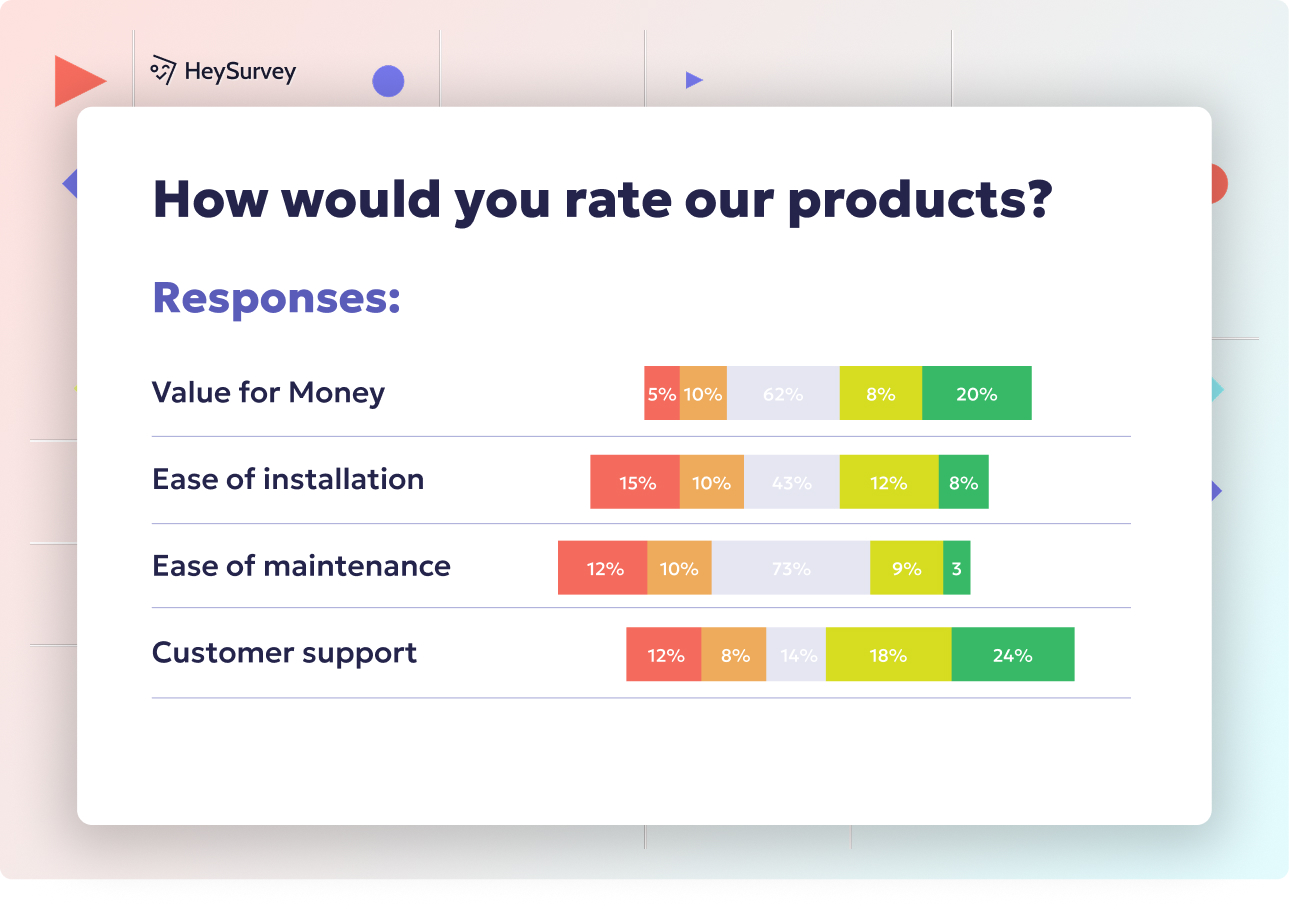
31 Change Readiness Survey Questions to Boost Your Success
Discover 25+ sample change readiness survey questions to assess attitudes, barriers, and confiden...
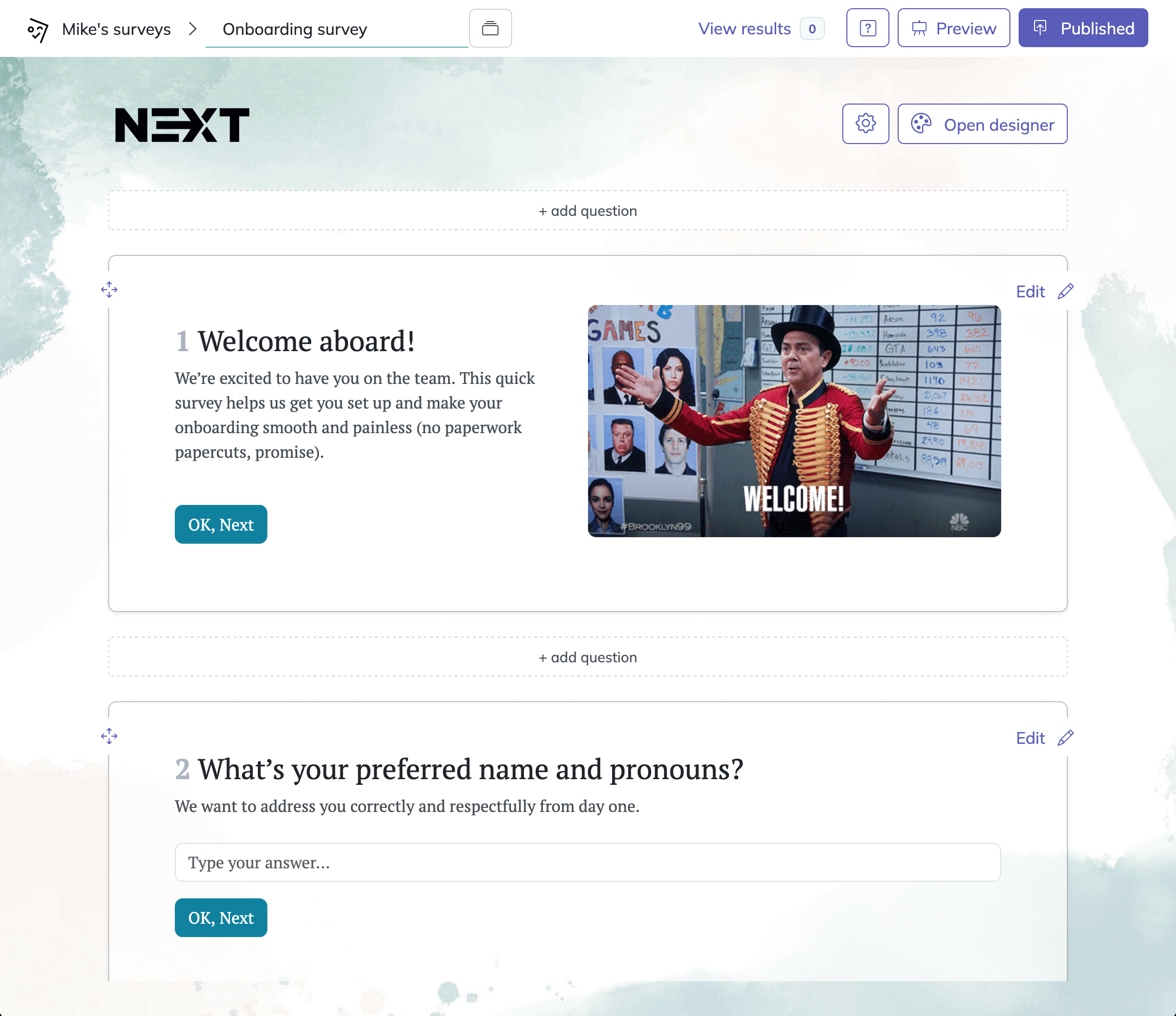
31 Retreat Survey Questions to Collect Actionable Feedback
Discover 26 essential retreat survey questions to gather actionable feedback before, during, and ...
